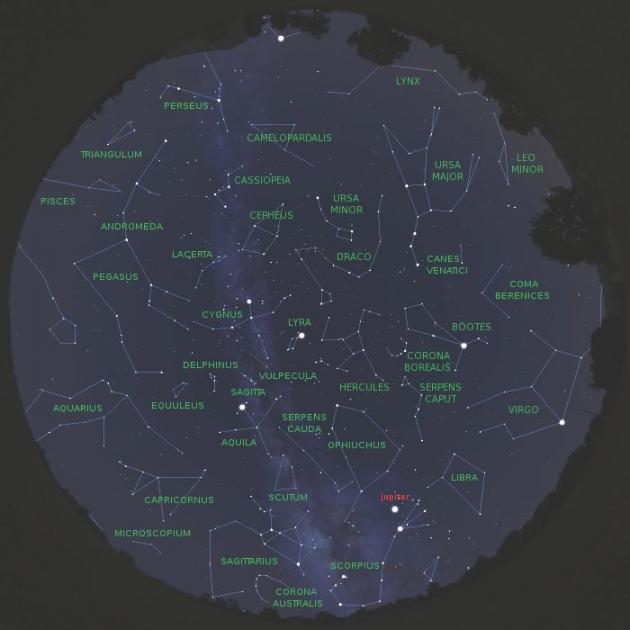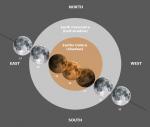- News / Thoughts
- Astronomy Guide
- On This Day
- Reviews
- Bookstore
Astronomical Events for August 2007
09/24/2007The only planet we'll be able to observe this month will be Jupiter. Although it's bands are usually full of details, and most observers love to catch it's big red spot, this year Jupiter will skim so close to observers horizon that our atmosphere will wash away most of those features.
Of three space missions planned for this year, only one has been launched as planned. The successful one, NASA Phoenix started at the beginning of this month it's journey towards Mars north pole, where it will explore history of waters on Mars, try to find out if Mars soil is capable of supporting life, and represent the first weather station on one of the Mars poles.
Also this month you can watch one of the best known meteor showers - Perseids. Comfortable temperatures, and no moonlight ought to make this a nice show for us.
O

Evening sky for the middle of August 2007. at 09:30 PM. The map is valid for northern hemisphere, especially positions near 45 degrees latitude.
This month, the only planet we can observe in the evening hours is planet Jupiter. We have a tough luck this year since it skims so low near horizon. Since we are thus looking through enormous amounts of our atmosphere, even at best times we can only hope to see a glimpse or two of the details on Jupiter cloud bands. Even spotting big red spot, and the little junior spot will prove to be difficult and frustrating. Hence I can only recommend looking at it's largest moons now and then, to see their ever changing positions. On the bright side, they shouldn't be difficult to spot even with just moderate binoculars.
Truth be told, we can see the planets beyond Jupiter too. Those are Uranus and Neptune, and if we try very very hard, even dwarf planet Pluto. But in practice you'll barely see more then a faint, star like, dot void of any detail.
Planet Venus this month passes very close to the Sun. We have to be extremely careful, but if we take needed precaution we can observe her during the daytime. Throughout this month you can see fast change in Venus phases. At the beginning it'll appear as a crescent forming a letter D, on August 18, it'll show us it's dark side, hence it'll be unobservable, but just a few days past it'll begin to show again as a crescent looking like letter C.
Also this month, two space missions have been planned for departure from Earth. Unfortunately JAXA (Japanese Space Agency) found some problems on their SELENE mission and postponed it for September. On the other hand NASA Phoenix mission successfully started it's ten month journey toward Mars' north pole.
At the beginning of this century NASA has come up with a concept of cheap scout missions to Mars. Each mission would have smaller number of tasks to do, and would use lower priced, generally available components as much as possible. Phoenix is the first scout mission of such kind. They've gone so far to call it Phoenix just because major modules were not done specifically for this mission, but used from previous discontinued missions.
Phoenix mission objectives are:
- Study the History of Water in All its Phases - One interesting thing about Mars' north pole is that it's altitude is lower then southern territory and generally it looks quite flat. Could this be a clue that this area once was large ocean? Even today the largest amounts of water on Mars are in this location, either as ice or in the form of permafrost. Upon it's landing Phoenix will start to research the cycle of thaws and freezings of water during changing Mars seasons and give scientists valuable data which they'll use to figure out the history of water on Mars.
- Explore Mars soil characteristics - Majority of life we know today is water based, but the fact is that it doesn't need continuous access to water. As seen on Earths harshest climate conditions in polar regions, microorganisms hibernate most of the time, only to be brought back to life for a short time when the climate is right. It should be noted that Phoenix can't detect life itself, only if the soil can harbor right conditions. Other characteristics of soil will be researched along as well.
- Research weather conditions on Mars' north pole - Phoenix will be the only instrument so far positioned on either of Mars' poles. Polar regions experience major weather changes. During Mars' spring and autumn huge amounts of water begin to move, by changing from ice and permafrost into gaseous state, and the other way around. A couple of weather instruments on Phoenix will give us better understanding of meteorological conditions on Mars.
At the middle of the month Earth will pass through the tail of Swift-Tuttle comet. When it traverses through its densest part, in the night from Sunday to Monday, on August 13., we can watch Perseid meteor shower. During those days Moon is in new phase, so its glow won't get in the way. Given that, we can expect up to 90 meteors per hour. The best viewing times is after midnight, in the direction of constellations which border constellation Perseus.
o
O

Moon eclipse timings for August 2007.
Almost half a year ago, on March, some of us, located in Europe and Africa, could watch total Moon eclipse. This month, residents of the other half of our planet, mainly North and South America, Australia and most of Asia, will have their Moon eclipse show.
Moon eclipse is ideal for popularizing amateur astronomy, since it's easily viewable only with unaided eye. So it's time to bring your close family and your friends, and party under the red Moon. An occasional glimpse every 15 minutes is all you need to experience this relatively rare event.
o
O

Moons eclipse path.
The event starts on August 28th with the following times:
- t1 - 07:53 UT
- t2 - 08:51 UT
- t3 - 09:52 UT
- t4 - 10:37 UT
- t5 - 11:22 UT
- t6 - 12:23 UT
- t7 - 13:21 UT
Please note that the times are in Universal Time, so you'll need to convert them to your local time.
As always let me just give you moon phases for this month:
- Last Quarter - August 5. 21:20 UT
- New Moon - August 12. 23:03 UT
- First Quarter - August 20. 23:54 UT
- Full Moon - August 28. 10:35 UT